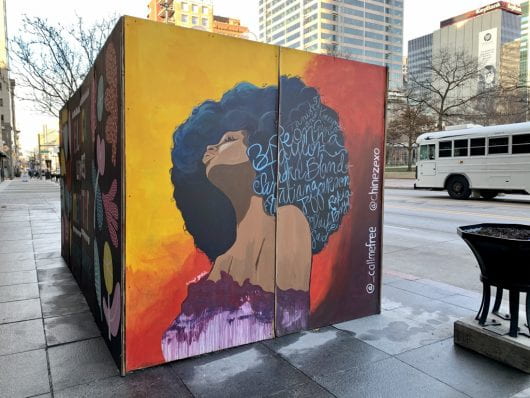
Boarded up windows and doors display works of public art memorializing the Black Lives Matter movement and victims of police violence. Credit: Sarah Trombetti | Lantern Reporter
From the plywood of the Ohio Theatre in downtown Columbus to brick walls in Clintonville, Ohio, public art mourned the loss of Black lives to police brutality and racial violence this summer. Almost a year later, local artists continue to transform public spaces into art that cries for justice and systemic change.
The Columbus Association for the Performing Arts and the Greater Columbus Arts Council facilitated the beginning of the movement in the aftermath of George Floyd’s death last summer through an initiative called #ArtUnitesCbus. Local artists transformed the plywood which boarded the doors and windows of businesses during protests into murals as a tool to create dialogue about racial justice.
“Art and activism can give hope. They can give a voice to a perspective that’s difficult for others to understand, and they can create a common starting point for dialogue,” Jami Goldstein, vice president of marketing, communications & events for GCAC, said. “They’ve also given a bigger voice to Black artists and people of color, which we need.”
This spring, artists will construct three to six large-scale murals as part of “Deliver Black Dreams,” a project aiming to connect art to systemic change by preserving the public pieces and giving them a permanent home.
Initially, CAPA and GCAC launched #ArtUnitesCbus to cover the plywood over the broken windows of their own property. Now, a digital map on the initiative’s website displays 167 murals from June 2020 — 32 of which have been added since the summer.
Goldstein said that the role of the art institutions who supported the initiative was influential in the movement of public art as a means of activism.
“That’s where true change is going to take place,” Goldstein said. “It takes all of us, especially the art institutions, which are tremendously white-centric, to look at our errors of the past and chart a new course.”
Besides supporting murals and other public art, GCAC took other actions during this time, such as planning for exhibition of the murals, awarding Black filmmakers and photographers who documented the protests as they experienced them though their voices, privately funding murals and mentoring young artists in Columbus.

Works of public art celebrate black lives and black history around Columbus. Credit: Sarah Trombetti | Lantern Reporter
“Public art was sort of used as a launching point, but we need to make sure that the most vulnerable among us are being heard and have the opportunity to thrive,” Goldstein said.
Goldstein said both CAPA and GCAC were shocked by the public’s engagement with the art.
“So many people came out of the woodwork to care about what happened to these murals and to want to see their life extended in a way that more and more people could see them,” Goldstein said. “Literally the week they were being created, people started to contact us and say, ‘What’s going to happen to these?’”
As the artists and the organizations of #ArtUnitesCbus watched their community invest in their work, Goldstein said they decided on relocating works around the city for more people to see as part of “Deliver Black Dreams.”
“It became clear last fall that there was a hunger to continue to see [the murals] in some format because this conversation (about racial justice) is definitely not going away this time,” Goldstein said.
The “Deliver Black Dreams” campaign’s name was a dream of Marshall Shorts, principal at Artfluential and co-creator of Creative Control Fest, who joined the Maroon Arts Group and GCAC to lead the surge of public art for activism last fall.
However, Shorts said he felt conflicted about the intentions of the movement when it began last summer.
“The reason the art went up was really to protect businesses, and the reason the police were there was really to protect businesses,” Shorts said.
After seeing businesses reopen and dispose of the art, Shorts said he saw this vulnerability of other Black artists as an opportunity to put his time and effort into protecting their voices and work, with the long-term goal of achieving racial equity, and “delivering Black dreams” in a way that the city had never been able to do.
“I saw an opportunity to say, ‘This art can be more than a reminder. It can be connected to policy work and systemic change,’” Shorts said.
“Deliver Black Dreams” is about connecting public art to tangible systemic change, Shorts said in a press release. He said public art gives artists a voice through which to convey messages by telling their stories, but “Art alone doesn’t make change.”
“I like to quote W. E. B. Du Bois, who said, ‘All art is propaganda,’” Shorts said.
Like the role of businesses in #ArtUnitesCbus last June, Shorts said he feels conflicted about the role of the city’s government in developing “Deliver Black Dreams.”
“The opportunity with the city is that this is done at a scale that we might not have been able to do on our own, but it’s also on us to make sure that the story of ‘why’ doesn’t get lost with some of the agenda of the city,” Shorts said.


